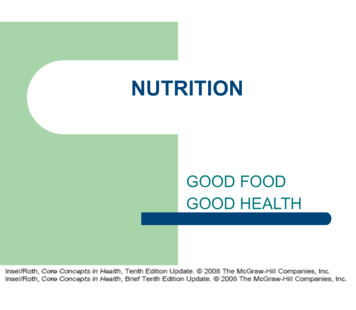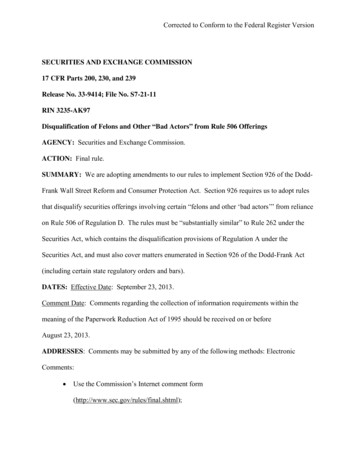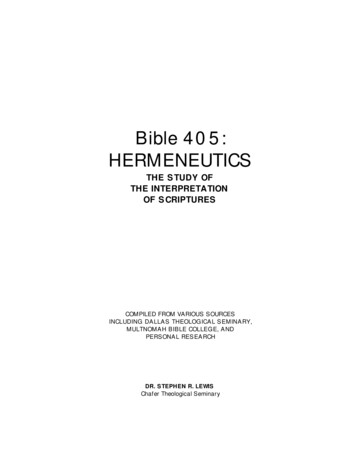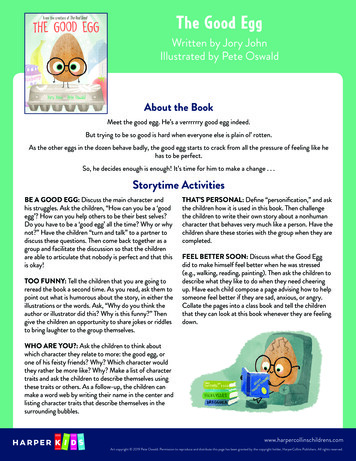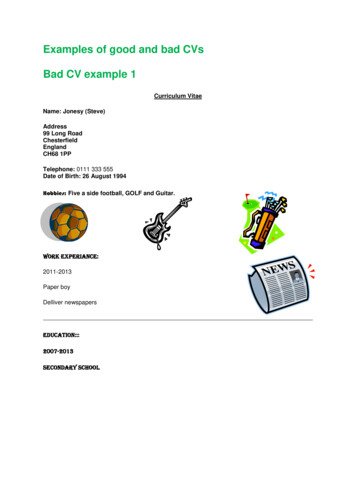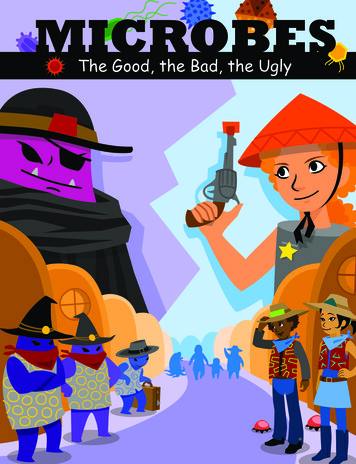
Transcription
MICROBESThe Good, the Bad, the Ugly
Table of ContentsPrologue.1Microbes Comic.2The Story Behind the ScenesBacteria Overview.13Identifying Bad Bacteria.17The Human Microbiome.18Important Vitamins.20Lacto and E. coli.21Strep Throat.22Yogurt and Probiotics.22Antibiotics.23MRSA.25Phage Virus.26Nanotechnology.26Receptors & Cell Surface Markers.27Words To Know .28Credits.29Conrad StoradThe Story Behind the ScenesKarla MoellerEditorSabine DevicheIllustration, Design and Original ScriptGustavo CastanedaAdditional Illustration for Story Behind the ScenesWeb Versionaskabiologist.asu.edu/microbesMicrobes is printed on FSC certified paper
Deputy LactoDeputy E. coliSheriff PhageStrep BacteriaMRSA the ResistantBacteria BanditsPrologueYou may already know that some bacteria can make yousick. Unlike the bacteria that cause diseases and infections,most of the bacteria inside you right now are harmless andlive peacefully side by side with the cells of your body. Thesebacteria work together with your cells to keep other unwantedinvaders away and to help keep your body running smoothly.CastIn this story, you will see how good bacteria, antibiotics, andnew technologies help keep the bad guys from taking over thebody. Many bacteria appear throughout this story. They come inmany different colors, shapes, and sizes.Learn MoreThis icon lets you know that there is more you can learn aboutthis topic in the Behind the Scenes story.Words to KnowIf you find an orange word in the Story Behind the Scenes thatyou don’t know, you can find out what it means by looking inthe Words to Know on page 28. Arizona Science Center & Ask A Biologist Funded by the National Center for Research Resources of the National Institutes for Health Page 1
Our story takes place in the tinyhidden world inside your body.You might not realize it, but you arehome to trillions of bacteria, tiny lifeforms too small to see without thehelp of a microscope.Bacteria come here from many different places.Some float through the airin tiny particles of water.Some hop from person toperson through theobjects we touch, likemoney or door knobs.Others hitch a ride downthe digestive system withthe food you eat.Some kinds have lived here sincethe very beginning, when yourbody was just a couple days old.ZMany others (between 300and 1,000 different kinds)have moved in since.Human BodyPopulation:10 Quintillion Arizona Science Center & Ask A Biologist Funded by the National Center for Research Resources of the National Institutes for Health Page 2
Thriving bacterial communities exist in many different parts of the body.Others make themselvesat home in the plaqueinside your mouth.Little colonies even existunder your eyelids, on thesurface of your eyes.Some live on the surfaceof your skin and on thehairs of your scalp.Most folks in this town are good,helpful, law-abiding bacteria.Your body‛slargest bacterialcommunities existalong your digestivetract, in yourlarge and smallintestines.How areyou?Need ahand?Howdy!You mightknow it byanother name:your gut.Hello!They help with digestion and makeimportant vitamins the body needs.Vitamin Kkeeps blood andbones healthy.Hmmm.This placelooks nice!Biotin helpscell growth.eGutvillVitaminKBiotinOnce in a while, some prettyunsavory characters come to visit. Arizona Science Center & Ask A Biologist Funded by the National Center for Research Resources of the National Institutes for Health Page 3
Let‛s meet the heroes of our town. When bad bacteria come to visit, it‛sup to these deputies to keep bad guys from making themselves at home.Howdy,I‛m deputyLacto.How aboutthat one?Lookslike we foundour newhome!So, whatbrings you toGutville?Meetmy partner,deputyE. coli.Woah, youdon‛t belonghere.There‛s noroom here foryou folks.We‛relooking fora place tostay.Move alongnow!Usually, the body's defenses cankeep the bad bacteria fromsticking around.Good job,partner!EXITOther unwelcomedvisitors aren‛t quite soeasy to get rid of. Arizona Science Center & Ask A Biologist Funded by the National Center for Research Resources of the National Institutes for Health Page 4
These villains might come through the air,hitching a ride in drops of saliva from asick person who coughed without coveringhis or her mouth.This way,gang!Then they make themselves athome in the throat and tonsils.Oh no, thesehooligans are strepbacteria. Theycan cause serioustrouble!Strepthroat? What‛sthat?It makesthe throatscratchy and red,and makes it hurtto swallow.It can alsogive the bodyfever andchills.They mightgive thebody strepthroat!Sometimes the bad guys get out of control andare just too much for the body to handle alone.When that happens,we have to bring outthe big guns:Antibiotics.Uh-oh,they‛vetaken over thethroat! Arizona Science Center & Ask A Biologist Funded by the National Center for Research Resources of the National Institutes for Health Page 5
Antibiotic pills arebroken down in thestomach and smallintestine, releasingchemicals that arebad news forbacteria.Inside the small intestine, antibiotics areabsorbed into the blood stream. This networkof blood vessels carries the antibioticsthroughout the other parts of the body.StomachSmallIntestineBack in Throat Town, theantibiotics are working!Let‛s getout of here,quick!Meanwhile,in Gutville I don‛t feelso good.Antibioticstravel through theentire body, and can‛talways tell us normalbacteria from thebad ones.Strep bacteria are defeated,but many good bacteria fromGutville and other parts of thebody are hit as well.The once-thriving bacterialcommunities throughout theHuman Body are now ghost towns. Arizona Science Center & Ask A Biologist Funded by the National Center for Research Resources of the National Institutes for Health Page 6
It takes about 3 days for antibiotics toleave the body after the last pill is taken.To helpnormal bacteriareturn, a doctormight recommendeating yogurt.Bit by bit, good bacteria return.New bacteria move in to fill theempty spaces left behind.b,scrucrubsWhyyogurt?It‛s fullof good bacteriacalled cultures,or probiotics.Large families of bacteria move in withthe yogurt and other foods.Welcome!It doesn't happen overnight but aftera while, the towns are back to normaland running smoothly again.But peace and quiet might not last.One day a new band of strangersappear.A few came in through acut in the skin thatwasn‛t properly washed,and they multiplied fast.They were soon on themove, using the bloodstream to travel toother parts of the body. Arizona Science Center & Ask A Biologist Funded by the National Center for Research Resources of the National Institutes for Health Page 7
MRSA sets up camp in many places suchas the lungs, bone, blood, and skin.Bettermove alongMRSA, you‛renot welcomehere!We knowjust what todo with yourtype.Let meintroduce myself:I‛m MRSA theMy gangResistant. and I are takingover the entirebody!More antibiotics were taken to try toget rid of MRSA. This time, however,something unexpected happened.Oh no, theantibioticsaren‛tworking!Taking moreantibiotics willonly end uphurting us goodbacteria.Hahaha,you can‛thurt me!This is where cutting edgenanotechnology comes to the rescue!Who‛sthat?We‛rein serioustrouble!Howdy,folks!Nanotechnology dealswith making newmaterials andmedicines out of tinybuilding blocks such asatoms and molecules. Arizona Science Center & Ask A Biologist Funded by the National Center for Research Resources of the National Institutes for Health Page 8
My nameis SheriffPhage.MRSA theResistant.I've beenlooking for areal nasty outlawthat goes by thename of.Don‛t worrygood bacteria,I won‛t hurtyou.WAAD ORDEe,cnyatdis ce bosaeR pe hetcti ing stio t inb pti u an r agA dis seroimFrcSADTENWAEDTN ALIVERMI can tellby yourreceptors thatyou‛re not theones I needto find.Receptors arethose littlestructures on oursurfaces.Their uniqueshapes letthem bind withonly certainmolecules.Receptors?What arethose?That‛s right!All bacteria haveunique receptors onthe outside, kind oflike ID badges.I know I‛vefound the right villainwhen their receptorsmatch the shape on theend of my guns. Arizona Science Center & Ask A Biologist Funded by the National Center for Research Resources of the National Institutes for Health Page 9
I getit now!Myreceptorsdon‛t matchso you knowI‛m notMRSA.Phage Virus.we meetagain!Yes,exactly!MRSA theResistant.This bodyisn't bigenough forthe both ofus.ck kilc licc!GANB Arizona Science Center & Ask A Biologist Funded by the National Center for Research Resources of the National Institutes for Health Page 10
Urg.Gahhh!PhageVirus justdefeatedthe boss!Ok, who‛snext?We betterget out ofhere quick!Thank youso much!You sparedus good townsfolkfrom MRSA‛s gangwhen antibioticsweren‛t enough.No problem!My work isnot finishedyet.My posse ofphage viruses willkeep looking forMRSA's gang.We won‛trest until all ofthose villains havebeen defeated.Goodluck!Bye!The body can rest soundlyagain, knowing it‛s safethanks to our heroeswatching over it. Arizona Science Center & Ask A Biologist Funded by the National Center for Research Resources of the National Institutes for Health Page 11
obesMicrEDATNESCEETAK Arizona Science Center & Ask A Biologist Funded by the National Center for Research Resources of the National Institutes for Health Page 12
Bacteria OverviewThe world is alive with tiny things too small for thehuman eye to see. In fact, these living things areso small that we call them microorganisms. Manymicroorganisms (also called microbes) are made of asingle cell, like bacteria.Bacteria were among the very first life forms to appearon Earth. Thousands of types of bacteria are known.Many more kinds have not yet been described or evendiscovered. Scientists who study bacteria are called orbacteriologists.A very small worldThe metric systemSize does matter and bigger does not always meanbetter. Bacteria are small. According to experts at theCenters for Disease Control in Atlanta, Georgia, theaverage human being on Earth today is a little morethan 5 feet 9 inches tall. The average microbe is amillion times smaller.A meter is a standard metric unit of length. One meteris equal to 100 centimeters or 1,000 millimeters. It isequal to about 39 inches. That is just a bit longer than ayard stick.But meters are still way too big for measuring bacteria.So are centimeters and even millimeters. Scientistsuse the terms microns or micrometers to measuremicrobes. One micrometer is the same as one micron.One micron is equal to one millionth of a meter. Mostbacteria are from 1 to 10 micrometers long.Measuring things as small as bacteria can be verydifficult. Feet and inches just do not work well at all. Tomake it easier, scientists use the metric Dime10-910-10For every step down in scientific notation (100 to 10-1), an item gets10 times smaller. 10-5 is 1,000 times (10 x 10 x 10) smaller than 10-2 . Arizona Science Center & Ask A Biologist Funded by the National Center for Research Resources of the National Institutes for Health Page 13
A matter of scaleJust how many bacteria live on and inside our bodyat any one time? The number is big. Very big. Thenumber is so huge it can be hard to understand.Having a sense of scale can help. That meansbeing able to compare one number with another.For example, think about it this way. Scientistsestimate that there are about 5 million (5 x 106)hairs on the average human body. There areabout 7 billion (7 x 109) capillaries to transportblood rich in oxygen from the arteries to allthe cells in the body. The average body has 25trillion (2.5 x 1013) red blood cells. And the bodyitself is made up of 60 trillion (60 x 1012) cells.Those are big numbers. But they are small whencompared to the numbers of bacteria living onand inside the average human body. Escherichiacoli is one of the most common types of bacteriafound in the body. It lives in our digestive systems.Consider thisE. coli, one of the most common types of bacteria foundin the human body. Image from Mattosaurus.What if one single E. coli bacterium was allowed toreproduce under perfect conditions? After just one daythere would be 10 x 1028 E. coli bacteria.That is 100,000,000,000,000,000,000,000,000,000bacteria! Luckily, the human body keeps bacteria fromgrowing out of control most of the time.Where do bacteria live?Bacteria live everywhere. There are trillions upontrillions upon trillions of bacteria. Scientists estimatethat 5 x 1030 bacteria live on our planet at any onetime. What does that mean? Written out, that wouldbe 5,000,000,000,000,000,000,000,000,000,000bacteria. That’s a LOT of bacteria!Many bacteria live on, in, or under the soil. Onegram of soil, which is about how much you mightpinch between two fingers, may contain as many as40 million bacterial cells. Some bacteria live in water,with over a million bacteria in just a few drops.Bacteria live on the outside and inside of plants andanimals.Clumped together, all of those bacteria wouldweigh much more than every animal and plantliving on Earth, combined.5,000,000,000000,000,000,000,000,000,000
Rods, spheres, and spiralsBacteria come in many common shapes and sizes.Some look like spheres. These bacteria are knownas cocci. Some bacteria are shaped like rods.These are bacilli. Some bacilli are long, skinnyrods. Others are short, fat rods (coccobacilli).Other bacteria look like spirals or little corkscrews.They are called spirilla. Still other bacteria areshaped like commas. They are known as vibrii.But not all kinds of bacteria fit these four commonshapes. There are rare types that actually looklike stars or squares and some bacteria have noregular shape at all.BacilliCocciVibriiSpirillaViewing the microworldAny living thing can be called an organism. Whales,redwood trees, horses, and people are large organisms.Microscopic organisms include protozoa, bacteria, andfungus.You might be wondering about viruses. Viruses arethe smallest germ that we know, but they aren’t reallyconsidered organisms. They require the living body ofanother organism to make more viruses. Although theyaren’t microorganisms, they are definitely very tiny.They exist in what scientists call the submicroscopic world.Let’s compare size. Most common bacteria are about 1 to2 microns in diameter and 5 to 10 microns long. A micronis one millionth of a meter, or 1/100,000th of a centimeter.The human eye is amazing. Still, unaided, the smallestobjects our eyes can see are about 100 microns long.That is 1/10th of a millimeter. Under perfect conditions,without using magnification, you might be able to see alarge microbe such as an amoeba or a paramecium. Usinga magnifying glass would help, but only a bit.Scientists use light microscopes to study bacteria andother larger microbes. These instruments use a system oflenses to magnify an image. It is possible to see structuresinside a cell. You can see the nucleus, mitochondria,chloroplasts, and other structures as well.The human eye can see particles as small as 0.2 to 1micron in diameter but only with the help of the very bestlight microscope. Viruses are much smaller. Scientists needpowerful electron microscopes just to see their outlines.Top: Marburg virions from CDC, E. Palmer, R. Regnery.Middle: Ebola Virus from CDC, F. Murphy.Bottom: Influenza virus from CDC, E. Palmer, R. Regnery.Viruses range in size from 20 to 200 millimicrons indiameter. One inch contains about 25 million millimicrons.The most powerful light microscopes can bring bacteriainto view, but not viruses. Arizona Science Center & Ask A Biologist Funded by the National Center for Research Resources of the National Institutes for Health Page 15
Seeing “little animalcules”The first real microscopes were built in the early1600s. They were not very powerful. Scientistsused these devices to magnify things onlyabout 20 to 30 times their normal size. In the1660s, a Dutch craftsman named Antonie vanLeeuwenhoek devised ways to make bettermicroscopes. His simple devices were muchmore powerful than those used by anyone elsein the world at that time.Van Leeuwenhoek made microscopes thatcould magnify things to more than 200 timestheir normal size. He was the first person to seebacteria and write about them. Because of hisdetailed work, van Leeuwenhoek is called the“Father of Microbiology.”Van Leeuwenhoek wasn’t like most scientistsliving in the 1600s. He didn’t come from a richfamily. He didn’t have a university diploma orany special education in science. But he wasa skilled lens maker. And he was very curiousabout the world around him. Van Leeuwenhoekused his skills to build the best microscopes ofhis time. He used them to examine samples ofall kinds.The Dutch scientist saw things that no onehad ever seen before. Almost every sample heexamined was full of little life forms too smallto see with the unaided eye. Van Leeuwenhoekcalled these tiny organisms “little animalcules.”Like a true scientist, van Leeuwenhoek spenta lot of time recording what he saw in greatdetail. He was very patient setting up samplesand lighting to get the best possible view.He was the first to observe and describebacteria. He also saw muscle fibers and bloodcells flowing in the tiny vessels we know ascapillaries.Top: Antonie van Leeuwenhoek, 1680.Image from Jan Arkesteijn.Left: Reproduction of Leeuwenhoek’s microscope.Image from Science Museum, London.
Identifying Bad BacteriaFiguring out the “bad guys”Many important discoveries in microbiologyhappened during the 1800s. Two major questionsneeded answers. First, did microbes just suddenly(spontaneously) appear in rotting material? Manyscientists back then thought that microbes couldgrow in dead material without being producedby other microbes. If the microbes didn’t appearspontaneously, they would have to come fromsome other process.The great French scientist Louis Pasteur found theanswer. He showed that boiled water or any typeof material in which all microbes were killed orremoved (called sterilized) would remain clearof bacterial growth. This meant microbes did notspontaneously grow. However, sterilized fluid wouldonly stay free of bacteria as long as bacteria carriedin the air did not “infect” that fluid.The second question seems silly today. Scientistswanted to know whether microbes cause specificdiseases. If they did, how could one be sure whichmicrobe was responsible? Which bacteria weregood and which were bad?Robert Koch was one of many who took on the taskof answering this question. The German scientistdeveloped a set of rules, or postulates. Koch’s ruleshelp us tell the difference between actual diseasecausing microbes and those that are harmless.Koch used his ownpostulates to learn aboutanthrax, a life-threatening disease.He showed that anthrax in cattle wascaused by a bacterium. Scientists beganclassifying all kinds of bacteria and thediseases they caused by using Koch’s ideas.Today, scientists still use Koch’s postulates. For amicrobe to be considered a disease-causing agent,Koch’s rules state the following:1The microbe must be regularly found in thediseased tissue (like in the wounds causedby certain diseases).2The microbe must be able to be grownalone (called cultured), without otherbacteria. (Keeping unwanted microbes outis important to this process.)3If you introduce the microbe culture intoan organism that could carry the disease, itshould cause the disease.4The same microbe should be found onceagain in the diseased tissue of the new host.
The Human MicrobiomeTrillions of bacteria and other microbes live all over theoutside and inside the human body. Altogether, thesemicrobes are called the human microbiome. Manytypes of bacteria have a bad reputation. They cause allsorts of illness and disease. But other kinds of bacteriado many helpful things in the body.Scientists estimate that each of us carry 10 times morebacterial cells than all the cells that make up our body.Many kinds of bacteria live on our skin. Bacteria liveall over our bodies— there are lots in our mouths, too.They live in our saliva. And some bacteria even liveunder our eyelids on the surface of our eyes. However,the largest number of bacteria live in our guts.51. Bacteria in our gutsOur guts are important. The gut includes the stomach,small intestine, and large intestine. Together, thesepieces make up a large part of the digestive system.Scientists know that the gut has a huge impact on eachand every human body system. Some experts say thatas much as 70 percent of the immune system actuallylives in the gut.The human gut is home to more than 100 trillionmicroorganisms. This massive crowd includes morethan 400 kinds of bacteria. Some are good. Some arenot so good. And some are downright ugly and nasty.Good bacteria in the gut are important. They playkey roles in keeping the body working smoothly andefficiently. Nasty bacteria can make you sick. They cancause diseases and infections. Luckily, most bacteriainside you right now are harmless. They live peacefullyside by side with the cells of your body.463212. Bacteria in our stomachs3. Bacteria in our lungsOur stomachs are filled with powerful acid. The acidhelps to digest all of the food that we eat. Most livingthings cannot survive in acid. That includes mostmicrobes.The lungs are a major part of our respiratory system. Wemust breathe air to get oxygen into our blood. But airis always filled with microbes. Our lungs have built-inways to remove bacteria and other harmful microbes.Special cells produce mucous, which is the thick, stickysubstance that traps bacteria.Still, some types of bacteria can survive in the hostileenvironment of the stomach. Heliobacter pylori arebacteria shaped like tight spirals. Scientists know thatthis microbe can attach to the stomach’s cell lining. Itcan cause peptic ulcer disease and might be a cause ofstomach cancer. Scientists are still exploring what rolesthis bacteria may play in our digestive process.Other special cells are always moving the mucous out ofthe lungs. When you cough or sneeze, you might spewmillions of droplets of mucous into the air. That mucousis filled with bacteria. That is why it is always importantto cover your mouth when you cough or sneeze. Arizona Science Center & Ask A Biologist Funded by the National Center for Research Resources of the National Institutes for Health Page 18
4. Bacteria in our mouthsThe number and type of bacteria on any givenpart of the body varies from person to person.Plenty of bacteria live in our mouths. They live onour tongues and on our teeth. Bacteria are part ofa sticky substance called plaque. You brush yourteeth to get rid of the plaque.When you don’t brush well, the plaque hardens intoa substance called tartar. Dentists call it calculus.These same bacteria secrete acid that can dissolvetooth enamel. This can cause cavities and toothdecay. These bacteria are always in your mouth, butit is important to go see the dentist so that you canclean out old build up.5. Bacteria in our eyesSome bacteria even live on the cells that form theinside of our eyelids and the surface of our eyes.That cell lining is called the conjunctiva. Glands inour eyes make fluid constantly. That fluid keeps theconjunctiva moist. When we blink, the eyelids washaway bacteria, dust, and other harmful substancesfrom the surface of our eyeballs. Our tears alsocontain chemicals that keep bacteria from growingout of control.6. Bacteria on our skinOur skin acts as a barrier. It keeps nasty, diseasecausing microbes from getting inside our bodies.However, plenty of bacteria live in our hair, on ourscalps, and all over every square inch of our skin.Some live on the skin’s surface. Some live deepamong the many layers of our skin.Lots of bacteria are found near the tiny glandsthat produce oil and sweat. These glands providethe bacteria with water and nutrients to grow andreproduce. By itself, human sweat has no smell.The bacteria living near sweat glands play a role inproducing body odor. It’s true, bacteria can makeyou stink. Arizona Science Center & Ask A Biologist Funded by the National Center for Research Resources of the National Institutes for Health Page 19
Important VitaminsBiotinBiotin is also known as Vitamin H and Vitamin B7. Ithelps with cell growth and helps convert sugars tochemical energy your body can use. It also plays a rolein keeping blood sugar levels steady, which is especiallyimportant for people with diabetes. Biotin helps keepskin, the digestive tract, and nerves healthy. Your bodydoes not store extra biotin. Instead, it uses what itneeds at the moment and gets rid of the extra as waste.BiotinBacteria in your gut make most of the biotin in yourbody. Fortunately, they’re very good at this. These hardworking bacteria make way more biotin than your bodywill ever need. Thanks to these little guys, it’s extremelyrare for your body not to have enough biotin.Vitamin KEver scraped a knee, or had a paper cut? You mightnot realize it but your body is actually very busykeeping you healthy and strong. As soon as youget a cut or a scratch, your body springs into actionto repair it. The first step is to stop the bleeding.The blood vessels around the area tighten so lessblood flows there. Small discs called platelets rushto the scene and stick together in clumps insidethe broken blood vessels.Clotting proteins in the blood help hold theplatelets in place. The process of blood formingclots is called coagulation. Your body needsVitamin K to make clotting proteins. Vitamin K isalso important for strong bones. It helps with thestoring of minerals in your bones, which makesthem denser and less likely to break.VitaminKFortunately, it’s very easy for your body to getenough Vitamin K. Some of your Vitamin K comesfrom the food you eat. It’s found in leafy greenplants like broccoli, spinach, and Brussels sprouts.That’s one more good reason to listen to yourparents when they tell you it’s important to eatyour vegetables! Vitamin K is also made insideyour body by the bacteria in your gut. Arizona Science Center & Ask A Biologist Funded by the National Center for Research Resources of the National Institutes for Health Page 20
Lacto & E. coliDeputyE. coliEscherichia coli (E. coli)We already know that microbes live everywhere. Weknow that the human body contains more bacterialcells than human cells. And scientists estimatethat there are more bacteria in your mouth alonethan there are people living on Earth. But not allbacteria are bad. In fact, most are good. We couldnot survive without bacteria. Most bacteria in ourbodies actually work to keep us healthy. They fightbad bacteria.Normally, E. coli is a good kind of bacteria. It ismostly harmless. E. coli lives in our intestines andon our skin. It helps to break down food and keepsour digestive systems running smoothly. But a fewtypes, or strains, of E. coli can give us cramps andcause diarrhea. Infections from bad strains of E. coliare rare.Most people get infected from contaminated foodor water. Undercooked meat and raw, unwashedvegetables can carry the bad microbes. E. colibacteria can pass easily from person to person,especially when infected people don’t wash theirhands properly. That is why it is important to alwayswash your hands after you use the bathroom andbefore you eat or serve food.LactobacillusLactobacillus is one of many families of “goodbacteria.” These microbes live in our mouthsand intestines. They help to prevent theovergrowth of harmful bacteria.DeputyLactoA common form is called Lactobacillusacidophilus. It helps our body to maintain anormal balance of good bacteria. L. acidophilusworks by breaking down lactose and othersugars. It helps to promote healthy digestion. Arizona Science Center & Ask A Biologist Funded by the National Center for Research Resources of the National Institutes for Health Page 21
Strep ThroatEach of us has suffered with a sore throat at one time oranother. You feel icky. Your voice is scratchy. It just plainhurts. Lots of things can cause a sore throat. Viruses andbacteria cause them. So does pollen and cigarette smokeor other irritants in the air we breathe. Most sore throatswill heal without treatment. But some can turn dangerous.Did you ever have a sore throat that hurt a lot? I meanhurt really bad? If so, it may have been an infection calledstrep throat. The culprits were some particularly badbacteria called group A Streptococcus. We know thatmany types of bacteria do very helpful things for thehuman body. But others are outlaws and bandits. SomeStreptococcus are just plain nasty dudes.The group A strep bacteria can live in your nose andthroat. The tonsils are a favorite spot to infect. These nastybacteria are easy to spre
home to trillions of bacteria, tiny life forms too small to see without the help of a microscope. Some hop from person to person through the objects we touch, like money or door knobs. Some float through the air in tiny particles of water. Others hitch a ride down the digestive syste


